Oh but I adore the Lake District. Wild horses wouldn’t keep me away. Any excuse!
Don't wanna be here? Send us removal request.
Text
“the 1st thing she ever gave me”
I started working on just one sentence I read in Anne Lister's diary:
Wednesday 26 September 1832
“then called to inquire if Miss Walker was returned – yes! last night – sat with her from 12 50/” to 2 20/” – she had brought me a presse-papier from the marble works at Kendal”
After Miss Ann Walker returned from her trip to the Lake District in September of 1832 she brought a present for Miss Anne Lister. It seems it was the 1st ever present she gave her. It was a paperweight made of polished marble, bought in Kendal, a market-town situated on the border of today's Lake District National Park. Ann Walker indeed went to the Lake District with her cousin Catherine Rawson just like we saw it happen in Season 1 of Gentleman Jack. We know Anne did not follow Ann to Wasdale (a valley near Wastwater lake in the Lake District) and her going there was dramatized for the needs of the show.
Before Ann went on this trip, Anne and Ann had been enjoying each other’s company for just over a month. During that time Anne visited Ann frequently at her home at Lidgate; confiding conversations and gaining each other’s trust became a regular occurrence and the bond between them was growing stronger on a daily basis. However, buying a gift implied that the nature of that bond was likely to become even stronger in the future. Or at least, that was something Ann Walker was looking forward to.
A paperweight (press-paper or letter-press) – in French it's presse-papier – is a small heavy object whose purpose is to be placed on top of papers to keep them from blowing away. Any material can be used for its production, they can be more or less decorative, cheaper or more expensive, made as unique objects or on a mass scale. Workmanship, design, rarity, and condition determine a paperweight's value, and the ones made out of glass are often considered to be fine art.
I went reading on, checking through a couple of days later in Anne's diary hoping for some kind of description of this paperweight. No luck. There were some mentions though. Words in bold are bolded by me.
Later, on 26th September when Miss Lister got back home to Shibden after a whole day of work on her estate, she found Ann's manservant James with a note – Miss Walker asking her to return a couple of books she lent her, which Anne did and also replied:
“may I beg for my press-paper – now that you have given it me, I am impatient to have it – very truly yours, A Lister”
Two days later:
Friday 28 September 1832
“On my return home found on my desk parcel the Letter-press (presse-papier) and Note from Miss Walker – explaining about Collins, and that she should hope to find me in my walk between 3 and 5 – begins with “I have real pleasure in sending the letter-press, tho’ my own motive, and its possible utility are its only recommendations to your acceptance” – “
In the margin: “the 1st thing she ever gave me”
All transcription credits: Dorjana Širola
Before many questions I started asking myself about the paperweight, I couldn’t help noticing how appropriate, singled out and romantic this object would be as a present for Miss Lister. It confirmed my sentiments of Miss Walker as a person of good observations and excellent taste. Indeed an item more than harmonious with Miss Lister’s books and papers collection? I think so.
It would be thrilling to find out where this object is today, or if it ever left Shibden Hall. Unfortunately we don't know. Anne doesn't record at all what it looked like, she doesn't say what size or shape it is, is it just plain geometrical shape or more decorative and maybe a shape of an animal, flower, book etc. But there are some things I have managed to find out.
These websites (and many others) have been of great help:
http://www.stricklandgate-house.org.uk/historic-kendal/
https://www.feolifineart.net/artist.php?id=541
the page from Anne’s journal 28 September 1832
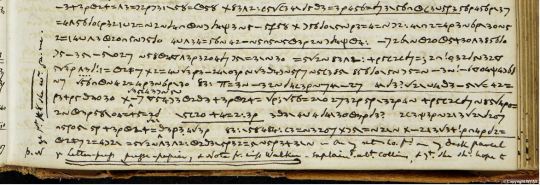

Credits: West Yorkshire Archive Service
These are screenshots from WYAS catalogue with the note made by Anne in the left margin of her journal page. The marginal note is also demarcated with two straight strokes of the pen from the rest of the text.
It seems she thought of adding this remark a bit later, after already filling the lines in the journal for that day, like she gave it extra thought and then noted it down this way.
Anne’s handwriting, in plainhand: “the 1st thing she ever gave me.”

Credits: West Yorkshire Archive Service
Francis Webster Sr.
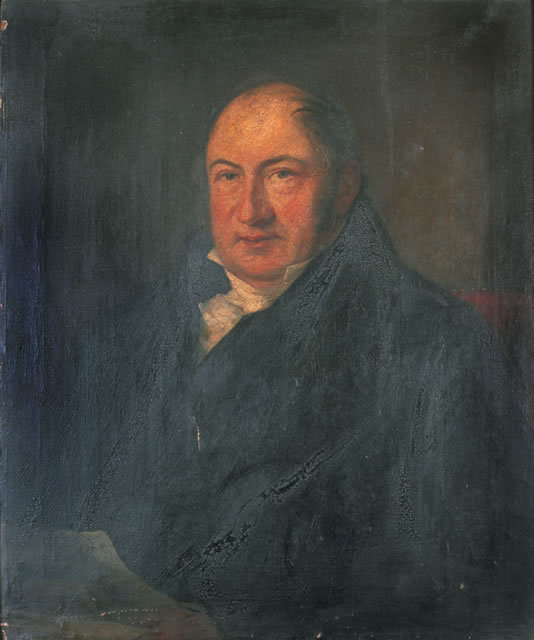
Credits: stricklandgate-house.org.uk
Francis Webster (1767–1827) started a successful and well known architect's business in the north of England in the 2nd part of the 18th century. His speciality was the production of marble chimney-pieces and funerary monuments. He introduced two of his sons, George and Francis Jr., to the business. Around 1800 the firm started with water-powered machinery for cutting and polishing marble at their mill at Helsington Laithes on the river Kent (a few miles from the town of Kendal). The type of marble he would have quarried there was called Dent marble. The stone is not actually marble, it is a highly polished form of black limestone. Its beauty and ability to take a highly polished surface in its final form is, in large part, due to the high percentage of fossils that it contains.
A specimen of Dent Marble
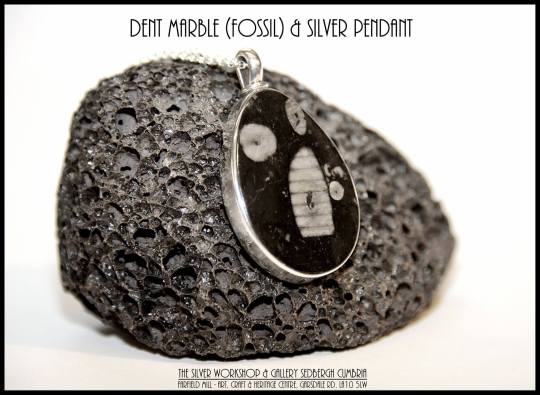
Credits: Gallery Sedbergh, Cumbria
A Chessboard made of Dent Marble
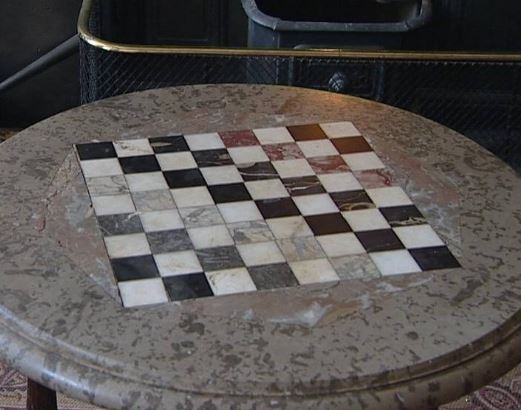
Credits: museumsintheyorkshiredales.co.uk/dent-marble
The larger of the two mills (both of which would have closed down by 1895) polished locally mined limestone for ornamental use. It seems the Websters produced all sorts of objects (including paperweights) to advertise and market their architects' business. These objects would have been sold at the showroom at Marble Works, today's Bridge House restaurant in Aynam Road in Kendal.
Francis Webster Senior's most notable achievements surviving today are many buildings in Kendal: schools, churches, assembly rooms, banks, mills, bridges, monuments etc. The Websters also worked on the construction of the Lancaster canal, which opened in 1819 and closed in the 1960s.
Marble Works, Kendal

Credits: stricklandgate-house.org.uk
Marble Works in Kendal, designed and built in 1819 by Francis Webster, architect, as his offices and showroom, is today's Bridge House restaurant in Aynam Road. In 1832 Francis Jr. was in charge of the Marble Works.
This is where Ann bought the paperweight in September of 1832.
We don’t know if she bought it on her way to Eskdale or on her return home to Lidgate, Halifax. She could have stopt at Kendal at any point, it being an important stop on the trade routes towards the north.
George Webster’s (1797–1864) architectural designs include classical public buildings and gothic churches, but his most important and innovative buildings were Jacobean or Tudor Revival country houses, such as Eshton Hall, Gargrave and Underley Hall near Kirkby Lonsdale. He also built 13 churches in the Gothic Revival Style.
https://en.wikipedia.org/wiki/List_of_works_by_George_Webster

St Mary's church in Rydal was also designed by George Webster, for Anne Frederica Elizabeth le Fleming (1784-1861), the Mistress of Rydal Hall at the time. When Anne visited Rydal in July 1824, the church was just about to be finished, and would be consecrated in December that year.
Paperweight made of Dent Marble
The only thing I am sure about the paperweight is that it was made of Dent marble, or more likely from smaller broken off pieces of Dent Marble, as slag in production. It could have been just a by-product of a more substantial industry so perhaps not a lot of artistry would have been invested in its crafting.
We don't know what the paperweight looked like. I imagine it looking like any of the examples on the photos I found online, although none of these are perfect.
From these examples it can be seen how marble takes on a nice polish. The object could have had sharp or canted edges; price would have also been a significant factor as well as a compromise between the practicality of the item and esthetics of the time. Perhaps even the fact that Anne didn't note down what it looked like suggests that it was a pure geometrical shape like the paperweights in these photos.
I haven't been able so far to find a photo of any paperweights produced by the Websters from Kendal.
Examples of paperweights Ann might have bought in September 1832, (all are made of marble, but not Dent marble):
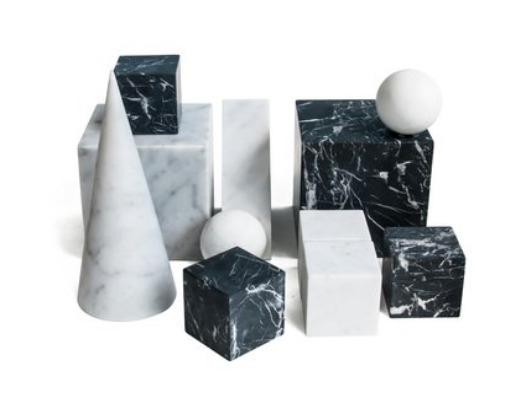
Credits: Pamono.eu



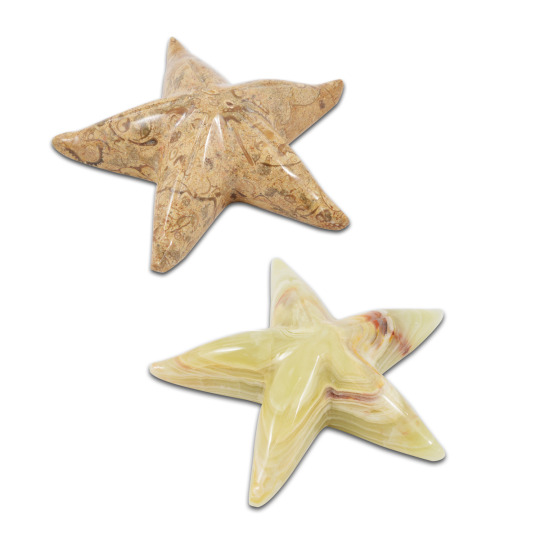
Credits: britishfossils.co.uk

Credits: lot-art.com
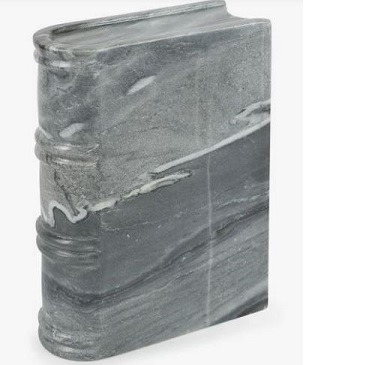
Credits: Oxford Exchange
I like how the symbolic value of this object has been noted down by Anne in her diary entry. It was one of the first material tokens of love between Anne Lister and Ann Walker resulting in them taking the sacrament on Easter Sunday in York in 1834 and living together at Shibden Hall, Halifax.
My guess is that this paperweight is still somewhere at Shibden Hall, having lain unnoticed for decades on Listers' writing desks or on top of piles of papers in the library tower. Of course, it’s more than possible that it might be, as well ... lost forever.
#paperweight#letterpress#presspaper#papierpresse#marble#webster#kendal#limestone#architecture#annwalker#annelister#gentlemanjack#lakedistrict
19 notes
·
View notes
Text
On Carriages and Gigs of Gentleman Jack and Anne Lister's Diaries
I started reading about gigs because I wanted to find out which gig Anne used when she travelled to the Lake District in 1824. This nonchalant question I've asked myself led me into a week long reading and transcribing pages from the diary that talk about Anne in York in autumn of 1821 buying that gig. (My wife did this generously for me, thank you). After I did find this out, I've asked myself what do we know so far about the other means of transport in Anne's time. Travelling was such an important part of Anne's life, and not just travelling abroad or long-distance travelling, but her often excursions to York by Highflyer or going to Langton by coach or in someone's carriage or taking a ride in the gig to Halifax or when she is in Langton with Tib. In one of the ALBW interviews we heard about how they filmed the scene with the Highflyer arriving to Halifax, or how Lister chaise was filmed in the air when being taken off the ship when reaching Copenhagen. But the topic of carriages and gigs certainly deserves more attention. The number of different models and types of carriages and gigs that are shown in the show is just amazing. Thank you Dorjana Širola for all the transcriptions. Thank you wikipedia and many websites for data and information. Thank you BBC for snapshots from the show.
Stagecoach
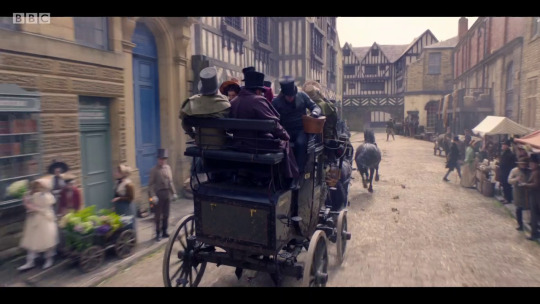
A stagecoach was a heavy and spacious horse-drawn carriage on 4 wheels pulled by 4 horses or mules. It could carry up to 20 passengers, some inside, some on the top of the carriage. Coachman was in charge of driving the coach or a carriage, having the control of the horses from an independent seat. He would usually be accompanied by a footman whose concern would be the passengers and transported goods. This was a public service coach meaning passengers would pay for the transport as well as for transport of their packages or letters. There was a net of posting stations scattered around the country where tired horses would be exchanged for fresh ones.
This one at the beginning of episode 1 must be the Highflyer, a type of stagecoach, that connected Halifax with other towns.
Coaching inn
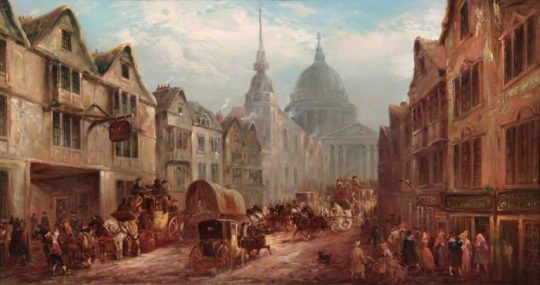
When people travelled in their own carriages or gigs, they would be accomodated in coaching inns. Coaching inns provided stables and food for horses but also accomodation for travellers for the night. Those that survived to today simply became regular inns or pubs, of course without stables provided (but it's fun tracking down the old buildings and finding remains of prior structures). Read here just about how much traffic jams involving this type of transport were regular back in the day: http://www.wickedwilliam.com/principal-departure-coaching-inns-1819/
Cary’s New Itinerary
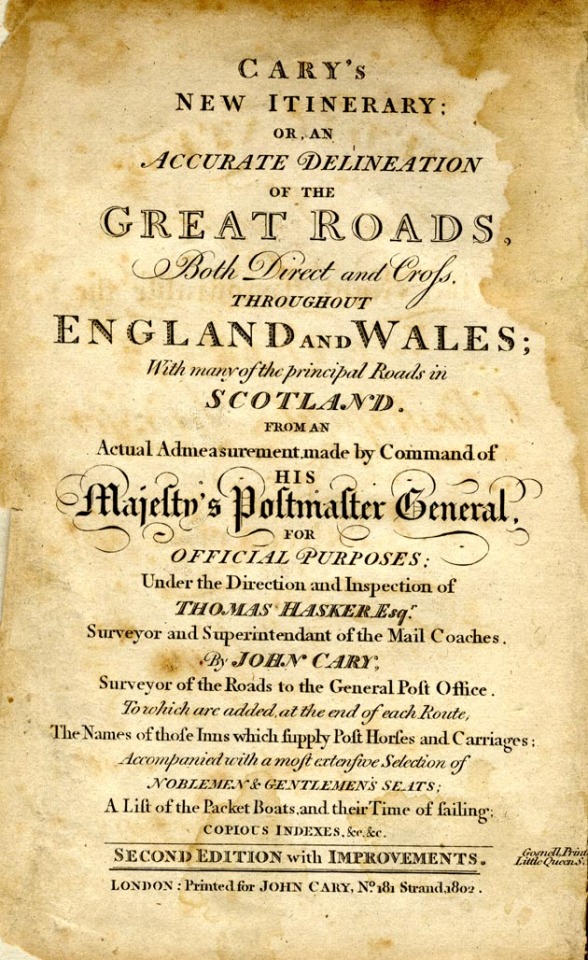
Travellers who travelled on their own were equipped with useful reference books on the road telling them where exactly they could find coaching inns and posting stations. The reference work of the time was Cary's New Itinerary, first published in 1798, on all the roads in England and distances between towns, and contained the “list of all Inns that supply post Horses and Carriages”. Anne used this while touring the Lake District in 1824.
photo credits: lakesguides.co.uk
The Lister chaise
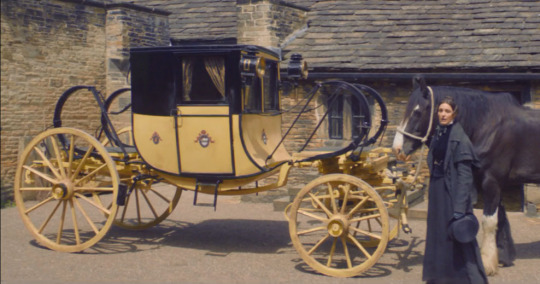
Listers owned the Lister chaise, built in 1725, one of the oldest preserved carriages in the world. You can see it in the stables of Shibden Hall, if you already haven't. We see it in episode 1.
Interestingly enough this carriage doesn't fit the description of a chaise at all which is a 2 wheel light carriage for 1 person, with a folding hood or a calash top. Instead it better fits to a description of a post chaise: it had a closed body on four wheels, sat two to four persons, and was drawn by two or four horses. A postilion would ride on one of the horses that pull the carriage. It seems to me that post-chaise became the term to mean public travelling carriages that would change horses at post-stations, and that's why Lister chaise is a chaise, and not a post-chaise.
The real Lister chaise
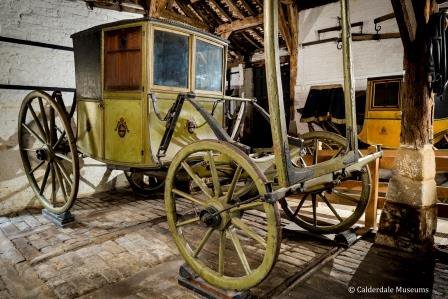
The Lister chaise looks a bit different than this one shown in the show. "The green and gold appears to be the original colours, although at some point it was painted grey, before being restored and returned to its original colours in the 1950s" says Calderdale Council's brochure on Shibden Hall. The one in the show is simply rejuvenated, together with the colours but the model is the same. Here is the photo of the real Lister chaise. Credits Shibden Hall ...
Anne bought a gig!
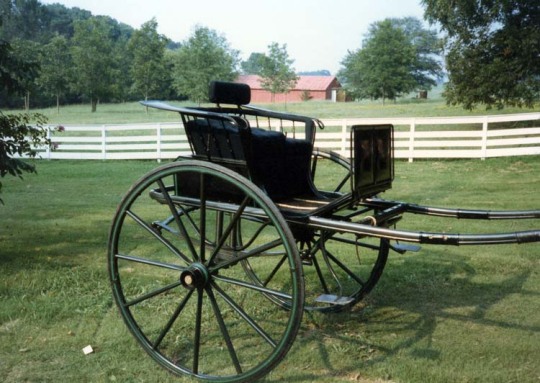
In the autumn of 1821 Anne went to York to buy a gig from the famous York coachmakers Breary's. She bought a second-hand one, probably a model of Stanhope gig for £65.2.0 which in today's money is £3.738.72. https://www.nationalarchives.gov.uk/currency-converter/#currency-result
Tuesday 23 October 1821
…Mr. Duffin and I… went to Breary’s to look at the 2nd hand gig with a top to it – afterwards took Dr. Belcombe and Anne to see it, and I think I have determined to take it…
Friday 26 October 1821
…Ord[ere]d the gig at Breary’s – Handsome brass harness (evidently only used 3 or 4 times) and lamps to the gig, all together to £48…
Tuesday 30 October 1821
…Letter also from Isabella Norcliffe (Langton) – John Coates (the head-groom) strongly advises me not to have the yellow gig, but the green one, which will cost £15 more – at 2, went to Breary’s to /sic/ look at it again, and intend to follow John’s advice…
Wednesday 31 October 1821
…Eli Belcombe… went with me to Breary’s where I ordered the green gig, with lamps and harness and all complete six[t]y guineas…
Wednesday 19 December 1821
Had the new gig from Breary’s, and George and I drove from the Dr. Belcombe’s door at 11 ½ - the mare a little awkvard at 1st, and I had not driven an hundred yards before I ran against the wheel of a cart – however we came along very well afterwards – I drove the whole way, and we got here (Lowgrange) in 3 ¼ hours, 19 miles…
Monday 24 December 1821
…Mariana and I went out together at 2 – went to Breary’s – I ordered lamps to my gig, and paid him for the gig and all its appurtenances £65.2.0…
Transcription credits: Dorjana Širola
A gig is a light two-wheel cart for 2 people drawn by one horse. We know her gig was green, she bought lamps to be added on and it had a top that could be pulled out in case of rain. In this gig she travelled to the Lake District in 1824 with her aunt. Caradoc, her horse, pulled the gig and George Playforth rode on a hack-horse. As a breed Hack-horse was a type of horse that could have been used for riding but also pulling carriages or gigs. Since there is no gig in the stables of Shibden Hall, I consider Anne's gig to be lost.
photo credits: CMA Archives
http://users.vermontel.net/~greenall/Rabers/Stanhope_Gig_R100.html
Anne’s gig was Stanhope gig !!

This is a photo of Stanhope gig, the exact model I think Anne bought. Notice the top that can be pulled in or out in the case of rain, also the visible space for luggage under the seat.
Just like carriages, gigs were considered to be status statements and subject to changing fashions. As well as there was a high number of different types of carriages available, the same applied to gigs.
The Stanhope was a lightweight gig, similar to a phaeton. It had a high seat with a closed back and plenty of storage room for luggage underneath it. The Stanhope gig was a very popular design, first built in 1815 by Tilbury, a London coachbuilder, for the Hon Fitzroy Stanhope.
Photo credits and more photos here : https://www.thecarriagefoundation.org.uk/item/stanhope-gig
The Dennett gig
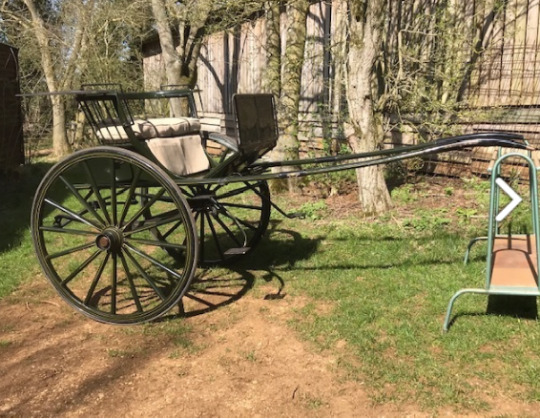
While she was buying the gig Anne was considering these other types of gigs, which were popular at the time.
The Dennett was also a two-wheeled gig driven by a single horse. It was enclosed at the rear and had room for luggage. Differences between the types of gigs consisted mostly in the number and arrangement of springs applied, and the additional space and equipment provided.
photo credits and more photos here : https://www.carriagelink.com/carriages?id=781528
The Tillbury gig
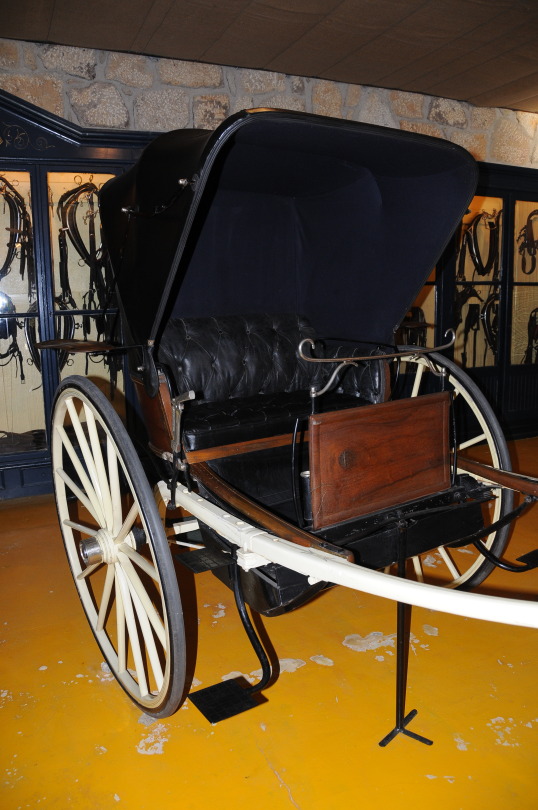
The Tillbury was a lightweight, two-wheeled, spindled-back seat gig, with no boot and no top. It was designed for short-distance rides around the town.
In Anne's own experience it's really difficult to understand all these types of gigs: “ ... surely the man at Leeds did not understand the difference between this [Tillbury] and a Dennet – there is a difference in the springs, the former having a cross spring, or more springs in some way or other the (lancer shafts) are more bent at the ends, and the box put under the seat is smaller than in a Dennet … ” (Transcription by Dorjana Širola)
Photo credits : Joseolgon
A Phaeton
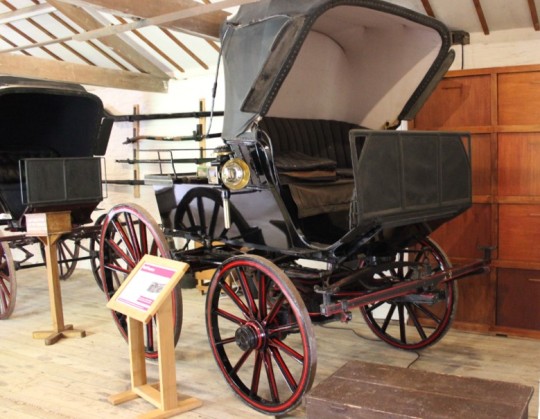
A Phaeton is a sporty open carriage, with a minimal body and typically with four extravagantly large wheels. It’s very lightly sprung and has no sidepieces in front of the seats. With open seating, it was considered fast and dangerous. Estate owners would gallop in them showing off. Phaetons can have a folded top as you can see here. If you want to know more: https://www.regencyhistory.net/2019/07/curricles-gigs-and-phaetons-in-regency.html
photo credits: By Museo del Bicentenario - Museo Casa Rosada
Rawson’s gig is a phaeton!
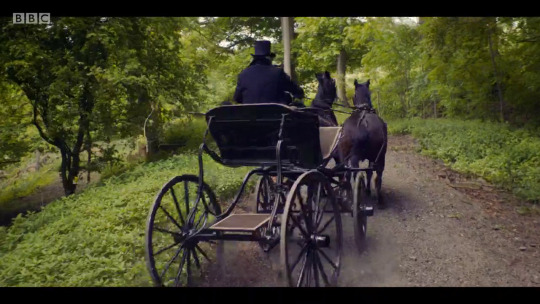
The gig from episode 1 that caused little Henry Hardcastle to lose his leg is actually a phaeton. Open, very fast and dangerous, with minimal space for anything else but the driver.
Mr Priestley’s carriage
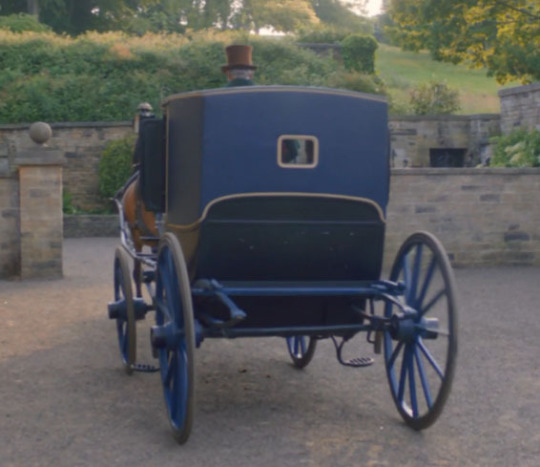
Another carriage from the show is Priestley's carriage in which Ann Walker drives away from Shibden Hall after visiting with the Priestleys at the end of episode 1. It's also shown when Mr Ainsworth is leaving from the Priestleys in episode 5.
Mrs Lawton’s carriage

There are many other carriages and gigs in the show. Like this one, that brings Mariana Lawton to Shibden Hall in episode 1. Carriage or a coach is a closed 4-wheeled vehicle pulled by 2-4 horses. Horses are controlled by a coachman who sits in a seat up front raised up high for a good view. For private carriages groom would usually do the duties of the coachman. A coach might have a built-in compartment called a boot, used originally as a seat for the coachman and later for storage. A luggage case for the top of a coach was called an imperial; the top, roof or second-story compartment of a coach was also known as an imperial.
Miss Walker’s carriage
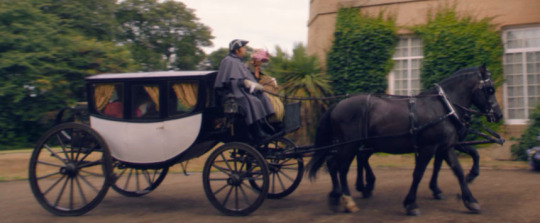
This is Miss Walker's carriage which we see a couple of times through the show. This is the carriage in which they went to York and back in episode 4 and the carriage which goes all the way to Scotland to take Ann back with James and the Priestleys.
Mrs Stansfield Rawson’s carriage
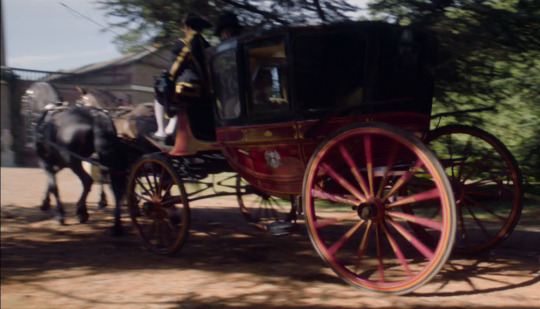
The carriage in which Mrs Stansfield Rawson and Miss Delia Rawson visit Ann Walker at the beginning of episode 3.
Mr Rawson’s Landau
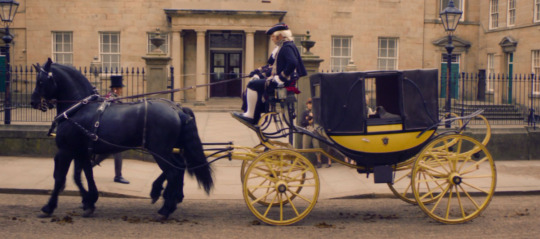
The type of carriage Christopher Rawson uses to get to work is called Landau. Landau is a type of a four-wheeled carriage with the folding top divided into two sections, front and rear, latched at the center. Both of the sides can be pulled down exposing the passengers to the fine weather. It was designed for transport through towns, enabling passengers clothes to be seen from outside. It was to become a matter of status and luxury to own one of these. Today in some cities Lord Mayors still use them in ceremonial occasions.
Landau with the top down!
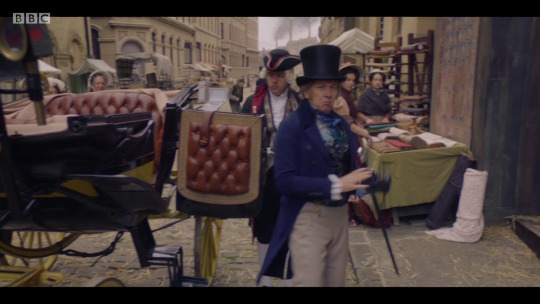
Another photo of Landau with dropped top on both sides.
Landaulette
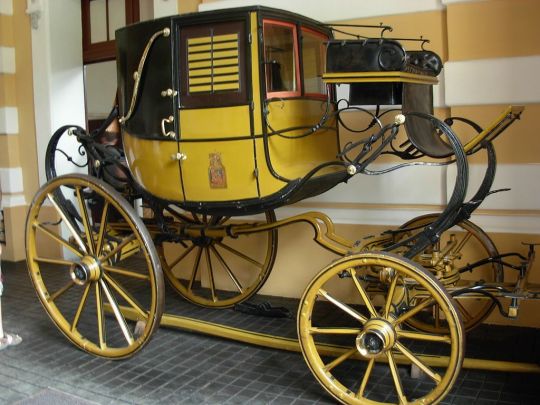
And then we had recently in Brian Moseley's transcriptions:
“Friday 14 April 1820 Down stairs at 10-1/4 - Mariana and I, went up to Whitewindows to see Mr George Priestley’s carriage horse, (only one as yet bought) and his new dark blue landaulette built by Windus, a great city builder in town [pret?] between 4 and £500, and which, with the Priestley and Lea arms, quartered, and those of Kirkman in an escutcheon of pret[ence?] done au large on each pannel, is a city-like looking concern.”
A landaulet or landaulette carriage is a cut-down (coupé) version of a landau horse-drawn carriage. The landaulette retains the rear half of the landau's two-part folding top.
Photo credits: Piotrus
Fly
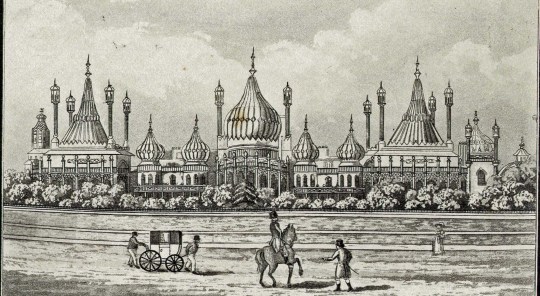
Again somewhere I read about another type of transport Anne used (sorry, can't remember where I read it!). Fly was a light horse-drawn public vehicle or a delivery wagon intended to move quickly and reach its destination in a hurry. Really interesting article here: https://brightonmuseums.org.uk/discover/2013/01/17/the-brighton-man-fly/
Lady Stuart’s carriage
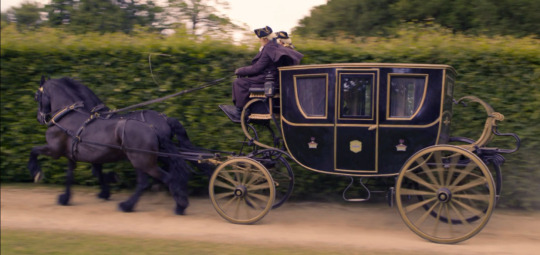
The carriage which Anne uses when travelling between Richmond and London when going for Vere's wedding in episode 2.
Mr Sutherland’s carriage
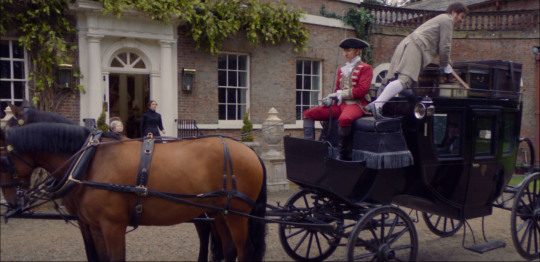
Another travelling carriage, the one that belonged to the Sutherlands in ep 7.
Anne’s yellow carriage
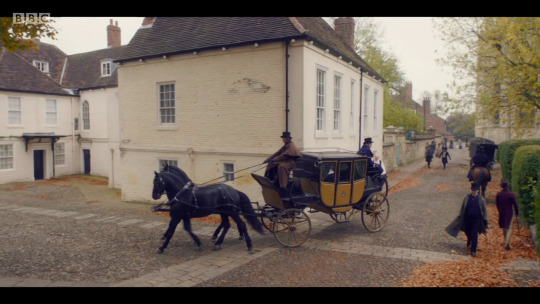
Anne had a carriage as well, which she ocassionally used for her travels. In the show we can see it in episodes 7 when she collects it from the Norcliffe's and stops at York to have a chat with dr Belcombe. Also when she is in London staying with Mariana. She goes to Copenhagen with Miss Ferrall in her carriage as well. Also they filmed Anne(s) in it going to the wedding.
Carriage on booaaaaard!!
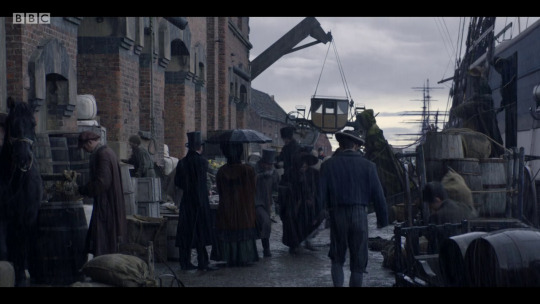
Or when she's arriving to Copenhagen, and the carriage is just being taken off the vessel. :) This is an excellent website on Regency types of carriages with good photos if you want to see more: https://regency-explorer.net/a-carriage-enthusiasts-paradise/
Caleche
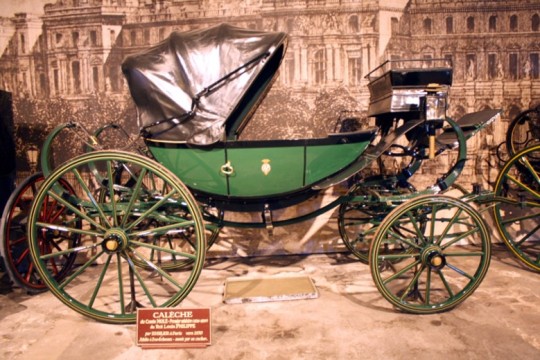
At the beginning of episode 8, aunt Anne reads Anne's letter sent from Germany: “At Kassel Miss Ferrall and I took a calache and went to visit the Palace d’Hercule … “ The calash was a light carriage with small wheels, a body in the form of a boat and a folding top. Inside, it had seats for four passengers, outside was a separate driver’s seat. The calesh was mainly used for pleasure driving in a park. The caleche was the forerunner of the barouche, a carriage fashionable in the 19th century.
Britzka
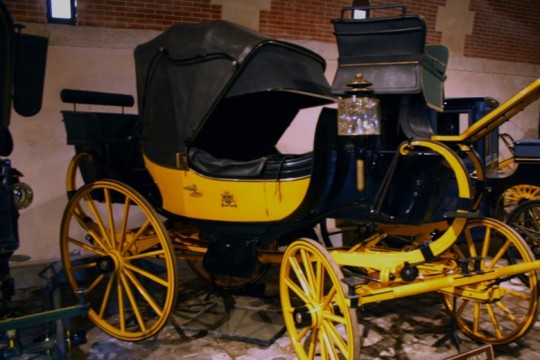
Just the other day I read this line in Anne Lister's diary : Sunday 5 October 1834 “saw my father and Marian off in their new Britska-phaeton” (Thank you gentlemanjackthelass on Insta) and, of course, had to google this type of carriage. Also wondering, are we going to see it in Season 2?
The Britzka is a type of opened horse-drawn carriage on 4 wheels pulled by 2 horses. And that’s about it with its similarities with the phaeton. Britzka was a long, spacious carriage with a folding top over the rear seat and a rear-facing front seat. It could be adapted with all manner of conveniences (beds, dressing tables and so on) for the traveller.
Read here about this and many other types of carriages and gigs: https://www.geriwalton.com/vehicle-titles-origins-descriptions-1700s-1800s-a-c/
#gentleman jack#shibden hall#anne lister#ann walker#rawson#priestley#carriage#gig#stagecoach#coachinginn#postingstation#postilion#stanhope#dennett#tillbury#chaise#postchaise#phaeton#landau#landaulette#fly#calash#caleche#britzka
11 notes
·
View notes